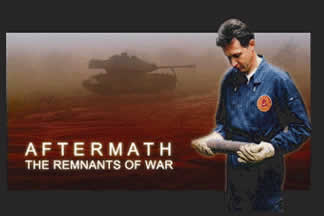







|


|


|


|
 HOME NEWS ABOUT COMING SOON
HOME NEWS ABOUT COMING SOON |

Produced by Storyline Entertainment in co-production with the National Film Board of Canada in Association with History Television and with the participation of Cinema Esperanca International, Canadian Television Fund - Created by the Government of Canada and the Canadian Cable Industry - CTF: Licence Fee Program, Rogers Documentary Fund, Aboriginal Peoples Television Network, Vision TV, Knowledge Network, Saskatchewan Communications Network and the Canadian Film or Video Tax Credit. |
Posted: Tuesday, Nov. 5, 2002, 6:52pm PT Aftermath: The Remnants of War (Docu -- Canada) A Storyline Entertainment presentation of an Aftermath Pictures and National Film Board of Canada production in association with History Television. Produced by Ed Barreveld, Michael Kot, Peter Starr. Executive producers, Don Haig, Andre Bennett, Louis Lore. Directed by Daniel Sekulich. Screenplay, Allen Abel, Sekulich, based on the book by Donovan Webster. With: Guy Momper, Henri Belot, Valery Shtrykov, Helmut Cronenbroeck, Phan Van Lu, Dr. Le Cao Dai, Chris Hatfield, Huynh Thiah, Dr. Nguyen Phuc, Veded Omerhavizovic, Mira Vilusic, Predrag Gavric. Narrator: John Jarvis.
By ROBERT KOEHLER " Aftermath: The Remnants of War" is a piercing critique of war's by-products, and, by extension, war itself. Canadian docu, co-produced by the National Film Board of Canada and based on Donovan Webster's book, bolsters no particular political agenda, but instead coolly observes what has happened in four former hot spots around the world in the years after peace has supposedly broken out. For all of its sobriety, pic contains what may be the single most horrific image in recent film history, as well as a frequent sense of imminent danger to the risk-taking subjects and filmmakers. A long trek through the docu fest circuit could lead to a commercial run, especially with the recent B.O. strength of such topical works as "The Trials of Henry Kissinger." Opening section looks at the painstaking work of French landmine sweepers, combing the countryside and new suburbs which sprawl into former hinterlands that might contain unexploded mines and bombs left from WWI; sweepers Guy Momper and Henri Belot face day-to-day threats from weapons more than 85 years old, some containing deadly chemicals used in trench warfare. The ghosts of history move on to WWII and the bloody battleground of Stalingrad. Helmer Daniel Sekulich follows the grim work of Valery Shtrykov, who is trying to identify and reclaim the remains of the battle's dead, both Russian and German. Virtually a one-man operation, the exhuming is observed as the ultimate act of reconciliation between both countries and their surviving vets. Yet Shtrykov's labors also seem quixotic: German dead number more than 800,000, while more than a million Russians perished. Pic's bitterest note is struck in the third section, reporting on the effects of spraying of Agent Orange by airborne U.S. forces during the Vietnam war. Sekulich focuses on the central Viet valley of Aluoi, where the dioxin-based agent was sprayed twice daily for three years in the mid-'60s, saturating the countryside with poisons and causing genetic defects in villagers' children. Most disturbingly, these defects continue to this day, as exemplified in an unforgettable shot of an Aloui baby whose deformed head appears to be at least 15 times larger than the rest of its tiny body. Shot crystallizes, in a jaw-dropping moment, pic's larger idea that the worst aspects of war often happen years after the main event. Conclusion in Sarajevo chronicles Predrag Gavric, who, like the Gallic mine sweepers, disarms and destroys munitions left behind after the Bosnian war. Like almost everyone else, Gavric was a combatant (against Serb rebels laying siege to the city), and suggests that his work is a way of making peace. Yet his grown children Dejan and Tamara are so worried and disturbed about their father's extremely dangerous work that they say they feel the stress of war now more than when the actual war was raging. An on-screen postscript reports that Gavric's colleague, Bengt Olsson, was killed by a landmine shortly after filming, prompting Gavric to quit. Vid-shot production is distinguished by National Film Board's tradition of quality, extending to John Jarvis' fine narration and doomy music by Claude T. Desjardins and Eric N. Robertson. Camera (color, video), Michael Grippo; editor, Deborah Palloway; music, Claude T. Desjardins, Eric N. Robertson; sound (Dolby), Adrian Tucker; supervising sound editor, Dwayne Newman; archival footage, Tanya Fleet, Hamish Robertson. Reviewed at Hollywood Film Festival, Oct. 6, 2002. Running time: 73 MIN.
Further media information please contact: |
|
copyright © 2005 storyline entertainment. all rights reserved. |